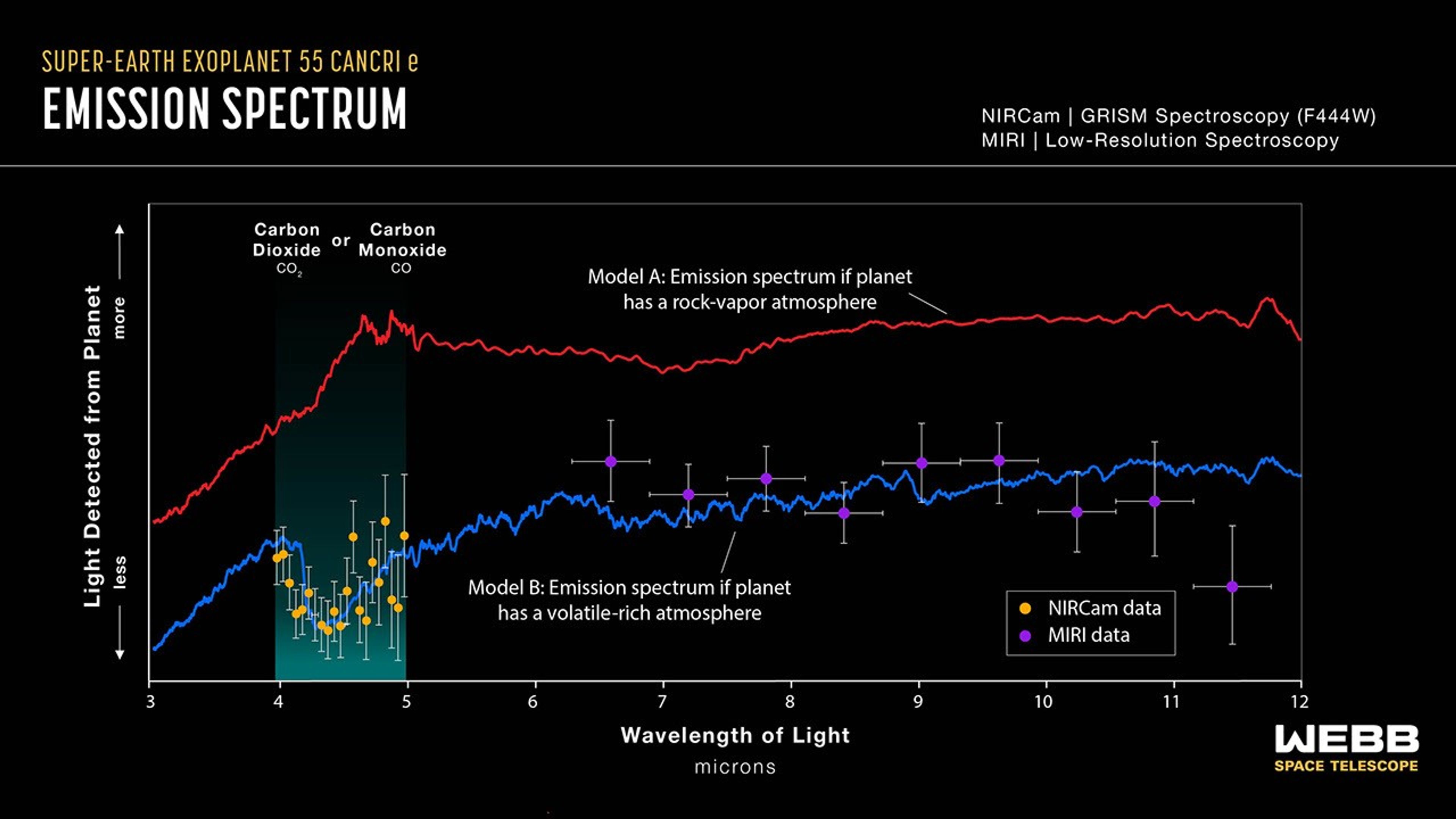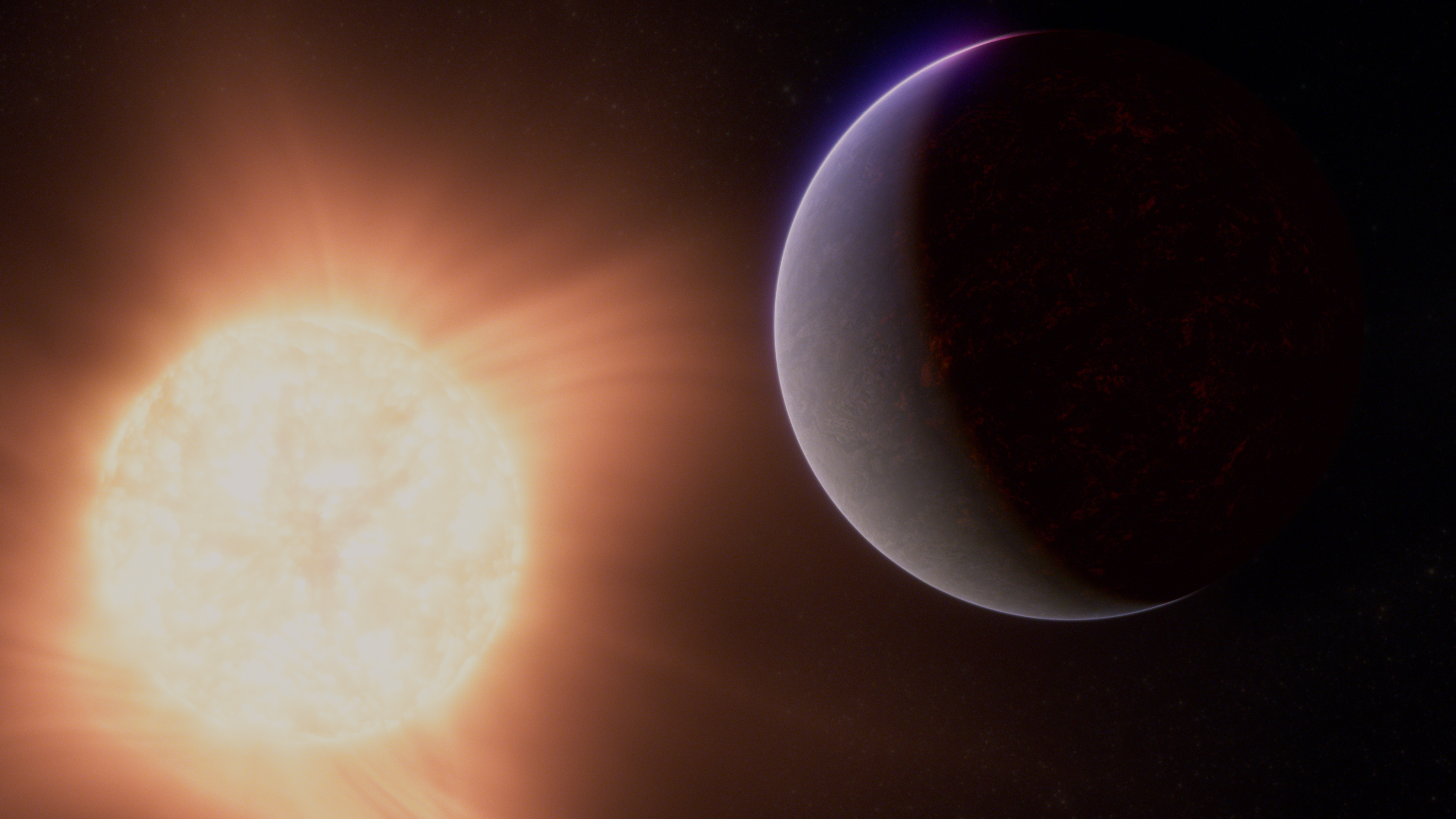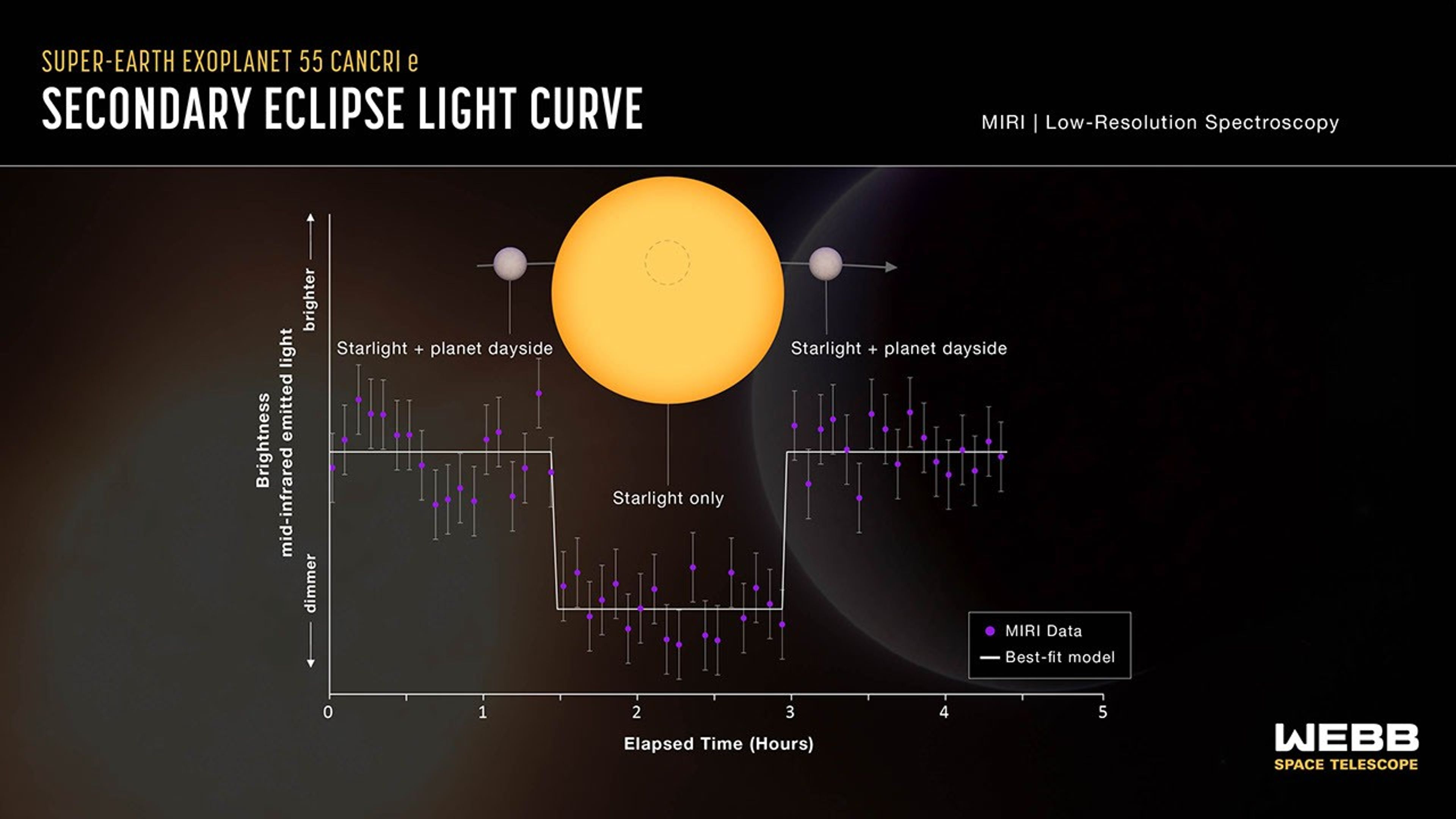1 min read
Super-Earth Exoplanet 55 Cancri e (NIRCam + MIRI Emission Spectrum)

A thermal emission spectrum captured by Webb’s NIRCam (Near-Infrared Camera) in November 2022, and MIRI (Mid-Infrared Instrument) in March 2023, shows the brightness (y-axis) of different wavelengths of infrared light (x-axis) emitted by the super-Earth exoplanet 55 Cancri e. The spectrum shows that the planet may be surrounded by an atmosphere rich in carbon dioxide or carbon monoxide and other volatiles, not just vaporized rock.
The graph compares data collected by NIRCam (orange dots) and MIRI (purple dots) to two different models. Model A, in red, shows what the emission spectrum of 55 Cancri e should look like if it has an atmosphere made of vaporized rock. Model B, in blue, shows what the emission spectrum should look like if the planet has a volatile-rich atmosphere outgassed from a magma ocean that has a similar volatile content as Earth’s mantle. Both MIRI and NIRCam data are consistent with the volatile-rich model.
The amount of mid-infrared light emitted by the planet (MIRI) shows that its dayside temperature is significantly lower than what it would be if it did not have an atmosphere to distribute heat from the dayside to the nightside. The dip in the spectrum between 4 and 5 microns (NIRCam data) can be explained by absorption of those wavelengths by carbon monoxide or carbon dioxide molecules in the atmosphere.
The spectrum was made by measuring the brightness of 4- to 5-micron light with Webb’s NIRCam GRISM spectrometer, and 5- to 12-micron with MIRI low-resolution spectrometer, before, during, and after the planet moved behind its star (the secondary eclipse). The amount of each wavelength emitted by the planet (y-axis) was calculated by subtracting the brightness of the star alone (during the secondary eclipse) from the brightness of the star and planet combined (before and after the eclipse). Each observation lasted about 8 hours.
Note the NIRCam data have been shifted vertically to align with Model B. Although the differences in brightness between each wavelength in the NIRCam band was derived from the observation (the data suggest a valley between 4 and 5 microns), the absolute brightness (the vertical position of that valley) could not be measured precisely because of noise in the data.
Extended Description and Image Alt Text
Extended Description
Graphic titled “Super-Earth Exoplanet 55 Cancri e Emission Spectrum, NIRCam Grism Spectroscopy (F444W), MIRI Low-Resolution Spectroscopy.” The graphic shows the brightness of 4- to 5- micron light captured by Webb’s Near-Infrared Camera and 6.5- to 11.5- micron light captured by the Mid-Infrared Instrument, plotted with two simulated emission spectra assuming different atmospheric conditions, and an illustration of the planet and its star in the background. The data are plotted on an xy graph of brightness of light versus wavelength of light.
Graph
Axes
The vertical y-axis, titled “Light Detected from Planet,” ranges from less at the bottom to more at the top. There are no units or tick marks.
The horizontal x-axis, titled, “Wavelength of Light” ranges from 3 microns at the origin on the left to 12 microns on the right, with labeled tick marks every 1 micron.
Key
A key is at the lower right shows that solid orange circles represent NIRCam data and solid purple circles represent MIRI data.
Graphed Data
Model Data
There are two jagged lines, one red and one blue, representing simulated spectra. The lines are separated vertically and do not cross or overlap. The upper line, in red, is labeled “Model A: Emission spectrum if planet has a rock-vapor atmosphere.” The lower line, in blue, is labeled “Model B: Emission spectrum if planet has a volatile atmosphere.” Each line has distinctive features: The red rock-vapor atmosphere line has a clear set of peaks between 4 and 5 microns, while the blue volatile-rich atmosphere line has a clear valley between 4 and 5 microns.
NIRCam Data
Twenty solid orange circles representing NIRCam measurements range from 4 to 5 microns. Projecting above and below the circles are vertical white lines representing error bars. The error bars are relatively long compared to the circles, and increase in length from left to right (shorter to longer wavelength). The data form a rough U-shape
Since the NIRCam data set has been shifted vertically to align with Model B, all of the data points or error bars overlap with the valley on the blue Model B spectrum for a volatile-rich atmosphere. This 4- to 5-micron portion of the graph is highlighted in green and is labeled “Carbon Dioxide CO2 or Carbon Monoxide CO.”
MIRI Data
Nine solid purple circles representing MIRI measurements range from about 6.5 to 11.5 microns. Projecting out from each circle are a vertical white lines representing error bars and horizontal white lines showing the range of wavelengths covered by the data point. The error bars are relatively long compared to the circles, and increase in length from left to right (shorter to longer wavelength). The data roughly follow the blue Model B spectrum for a volatile-rich atmosphere. Most, but not all, of the error bars overlap the blue Model B spectrum
Image Alt Text
Graph titled “Super-Earth Exoplanet 55 Cancri e Emission Spectrum” showing the brightness of light captured by Webb’s Near-Infrared Camera and Mid Infrared Instrument plotted with two different model emission spectra, and an illustration of the planet and its star in the background.
About the Object
- R.A. PositionR.A. PositionRight ascension – analogous to longitude – is one component of an object's position.08h52m35.24s
- Dec. PositionDec. PositionDeclination – analogous to latitude – is one component of an object's position.+28d19m47.34s
- ConstellationConstellationOne of 88 recognized regions of the celestial sphere in which the object appears.Cancer
- DistanceDistanceThe physical distance from Earth to the astronomical object. Distances within our solar system are usually measured in Astronomical Units (AU). Distances between stars are usually measured in light-years. Interstellar distances can also be measured in parsecs.41 light-years
About the Data
- Data DescriptionData DescriptionProposal: A description of the observations, their scientific justification, and the links to the data available in the science archive.
Science Team: The astronomers who planned the observations and analyzed the data. "PI" refers to the Principal Investigator.NIRCam grism time-series spectroscopy (F444W); MIRI low-resolution time-series spectroscopy (5-12 microns)
- InstrumentInstrumentThe science instrument used to produce the data.NIRCam and MIRI
- Exposure DatesExposure DatesThe date(s) that the telescope made its observations and the total exposure time.NIRCam: November 24, 2022MIRI: March 24, 2023
- Object NameObject NameA name or catalog number that astronomers use to identify an astronomical object.Planet: 55 Cancri e, also called Janssen; Star: 55 Cancri, also called Rho-1 Cancri, Copernicus
- Object DescriptionObject DescriptionThe type of astronomical object.Super-Earth Exoplanet orbiting a K-Star
- Release DateMay 8, 2024
- Science ReleaseNASA’s Webb Hints at Possible Atmosphere Surrounding Rocky Exoplanet
- CreditIllustration: NASA, ESA, CSA, Joseph Olmsted (STScI); Science: Renyu Hu (NASA-JPL), Aaron Bello-Arufe (NASA-JPL), Michael Zhang (University of Chicago), Mantas Zilinskas (SRON)
Related Images & Videos

Super-Earth Exoplanet 55 Cancri e (Artist's Concept)
This artist’s concept shows what the exoplanet 55 Cancri e could look like. Also called Janssen, 55 Cancri e is a so-called super-Earth, a rocky planet significantly larger than Earth but smaller than Neptune, which orbits its star at a distance of only 1.4 million miles (0.015...

Super-Earth Exoplanet 55 Cancri e (MIRI Secondary Eclipse Light Curve)
This light curve shows the change in brightness of the 55 Cancri system as the rocky planet 55 Cancri e , the closest of the five known planets in the system, moves behind the star. This phenomenon is known a secondary eclipse . When the planet is next to the star, the...
Share
Details
Laura Betz
NASA’s Goddard Space Flight Center
Greenbelt, Maryland
laura.e.betz@nasa.gov
NASA, ESA, CSA, Joseph Olmsted (STScI)
Renyu Hu (NASA-JPL), Aaron Bello-Arufe (NASA-JPL), Michael Zhang (University of Chicago), Mantas Zilinskas (SRON)































